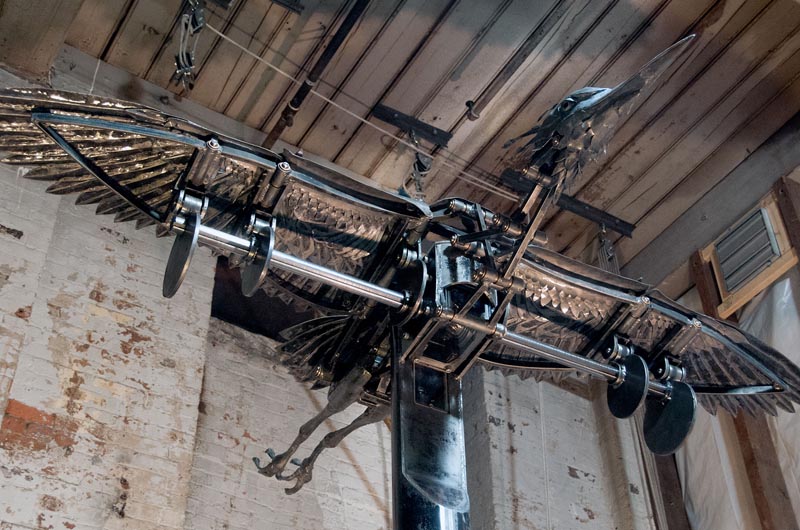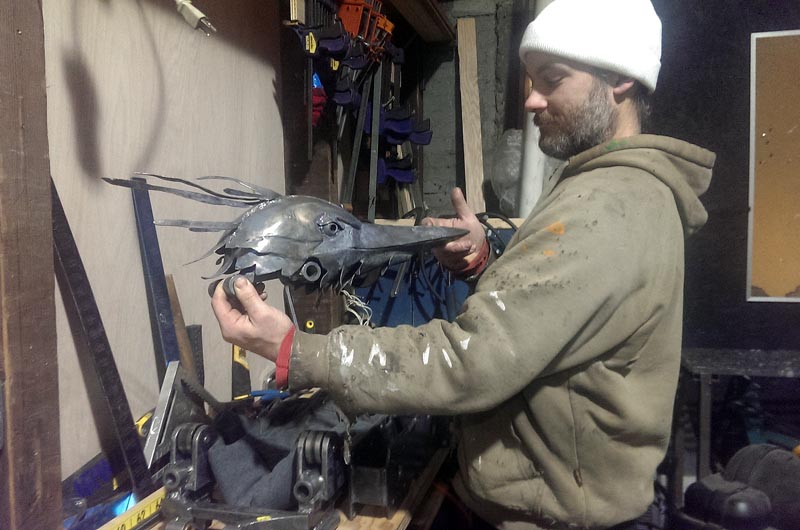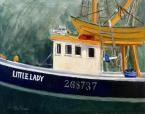The Brooklyn Navy Yard sits on the northern edge of Williamsburg, on the east shore of the East River. It hasn’t churned out a warship since the 1960s, or any kind of ship since the 1970s.
It’s now a business park, but it would be unfair to label its conversion another wave of Brooklyn gentrification. The park includes several manufacturing tenants, and the neighborhood in which it sits is still zoned for manufacturing. Unlike, say, the meat packing district in Manhattan, which has been a nightclub area for more than a decade, this is still a working area, the machinist district for the city of New York, with perhaps as many as 50 metal shops in a quarter mile.
For Tim Laursen, the character of the neighborhood serves as a muse as well as a practical locale for his work. He has converted a former ball bearing factory there into a workshop for his art, which involves building things of mechanical and ethereal beauty. Mr. Laursen has been and remains a carpenter, metal worker, construction worker, animator, prop and puppet builder as well as musician and pig-roaster par excellence with Local Smoke. For the past few years he has combined many of the skills he has mastered over a lifetime of working with his hands to make what he calls kinetic sculpture — sculpture that moves.
Mr. Laursen describes himself as the kind of guy who when he passes a bridge looks up at the underside to see how it was built. He attributes his lifelong interest in how things work, and in wanting to build beautiful things that work, to growing up on Martha’s Vineyard. It was here that he experienced first hand the Island ethos to make do with the materials available in a way such that Melville noted in Moby Dick that “pieces of wood in Nantucket are carried about like bits of the true cross in Rome.” It was also on the Vineyard that the young Mr. Laursen first learned to fix things with his hands when he went to remote control car races in Hyannis with his father. It was here that he met landscape artist Allen Whiting who taught him about practicality, building and beauty. Mr. Whiting showed him the reward in doing something over and over until you figure it out and get it right. It was here on the Vineyard that Mr. Laursen and his high school friends would go into the woods to just “build things,” like skateboard ramps and stick forts. It was here that he learned from the great art and shop teachers at the Island schools.
And it was here that South Mountain Company in West Tisbury employed and taught the 16-year-old Mr. Laursen about construction techniques. And it is for these and other Vineyard mentors and friends that Mr. Laursen does his work today.
His most recent piece is Sun-Bird, a kinetic sculpture that can be powered by solar power or a hand crank to create the flying motion of a large metal bird, approximately 12 feet long with a seven-foot wing span.

According to John Abrams, president of South Mountain Company, “We commissioned Tim to build the sculpture because a former client left us a bequest in her will that asked us to do an educational demonstration about renewable energy. We decided that an engaging kinetic sculpture, installed at Cronig’s in Vineyard Haven, would be an exciting way to educate the public about what’s happening overhead with the solar canopies in the Cronig’s parking lot. Tim has done a remarkable job; we think the finished installation — which will happen in the spring — will be quite spectacular.”
The beauty of Sun-Bird languidly flapping its wings blinds the viewer to the skill and effort required to make it so. Mr. Laursen actually built the piece three times, and after each of the first two attempts realized that he could do it better, and therefore there was no choice but to begin again from the ground up. In each rebuild there were several changes, but each version involved the painstaking work of refining again and again the asymmetric metal wheels that rotate underneath the bird’s body and wings to imbue it with the life-like sinusoidal flap. This was done by trial and error rather than computer simulation, resulting in a box full of asymmetrical metal discs that Mr. Laursen keeps for use in future projects. Another challenge in creating Sun-Bird was to build and integrate the numerous mechanical and aesthetic components of the piece, though many of the components serve both purposes. In his work, Mr. Laursen seeks to connect the awe with which we hold the natural world with the awe with which we hold the machinery we humans have created. And he leaves many of the mechanisms of Sun-Bird exposed so children can learn to love looking under the bridge, as it were, to see how it was built.
Mr. Laursen is looking forward to installing Sun-Bird at Cronig’s later this spring. It will be a way of paying homage to the community that is responsible for what he does today. But first things first; Sun-Bird had to migrate north to its new home, which it did earlier this week.
To get the sculpture to the Vineyard from his Brooklyn workshop, it had to be taken apart for transport. The central supporting shaft alone weighs about 400 pounds. And if you were hesitant about befriending Mr. Laursen lest he ask you for help getting it on the back of his Tacoma pickup, no need. He built a pulley system to do the heavy lifting, no help required.
After all, anything worth doing is worth figuring out how to do it yourself.







Comments (4)
Comments
Comment policy »